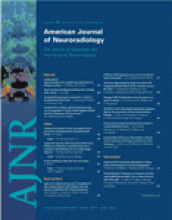Abstract
BACKGROUND AND PURPOSE: The association of cervical carotid artery bifurcation calcification to future stroke risk is unknown, though coronary artery calcification is a proven indicator of heart disease risk. Severity of white matter change has been correlated with future stroke risk. We sought to use white matter severity grade on CT as a surrogate predictor of relative future stroke risk and thus correlate white matter and future stroke risk with carotid calcification grade.
METHODS: We retrospectively reviewed unenhanced neck and brain CTs in 209 patients. Carotid calcification degree was scored by the Agatston method, adapted from that commonly used to quantify coronary artery calcification. White matter change severity was scored by the European Task Force for Age-Related White Matter Change scale. Both scores were measured blinded to each other, and to age and sex covariables. Association was tested by univariate and multivariate analyses.
RESULTS: Both carotid calcification and white matter scores were strongly, and independently, associated with increasing age (r = 0.61, P < .001; and r = 0.67, P < .001, respectively). Despite apparent association between carotid calcification and white matter scores on univariate analysis, there was no independent effect evident after adjusting for age as a covariant (r = 0.07, P = .14). Sex had no independent effect on white matter scores, though men had a marginally higher mean calcified carotid plaque load than women after controlling for age (P = .008).
CONCLUSIONS: Carotid calcification scores do not independently predict severity of white matter ischemia. Future stroke risk, assessed by white matter severity scores, cannot be predicted from carotid calcium scores.
- Copyright © American Society of Neuroradiology












